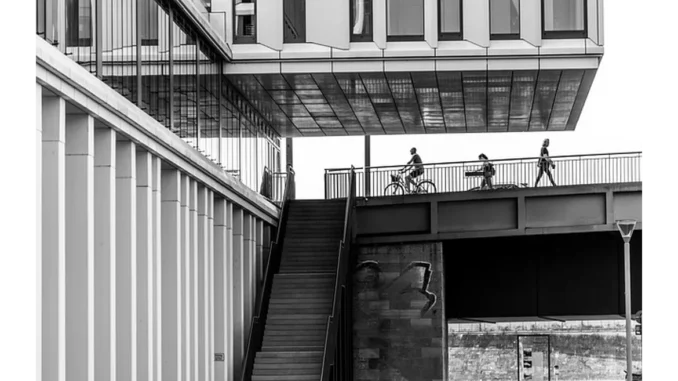
In the drive towards sustainable urban development, cycling has emerged as a pivotal element of contemporary transportation strategies. As cities endeavour to reduce traffic congestion and carbon emissions, the significance of end-of-trip (EOT) facilities in office buildings has become increasingly evident. This article delves into the multifaceted benefits of EOT facilities, examining how they enhance property value, support employee well-being, and contribute to overarching urban sustainability goals.
Focus360 Energy: property compliance services – pre-planning to post-construction. Learn more.
The Evolution of Urban Transportation
Urban transportation has undergone substantial transformations in recent years. With escalating concerns about climate change and urban congestion, cities are progressively advocating for cycling as a sustainable alternative to car travel. The advantages of cycling are numerous, including reduced greenhouse gas emissions, improved public health, and decreased transportation costs. As more individuals embrace these benefits, the popularity of cycling has surged, prompting governments worldwide to implement policies that encourage this mode of transport, such as dedicated bike lanes and public bike-sharing programmes.
The Role of End-of-Trip Facilities
EOT facilities are meticulously designed to support cyclists by providing essential amenities such as secure bike parking, showers, and changing rooms. These facilities address common challenges faced by cycling commuters, such as the need for safe bike storage and the ability to freshen up before commencing work. By offering these amenities, office buildings can significantly enhance their appeal to potential tenants and employees.
Enhancing Building Value
The presence of EOT facilities can have a profound impact on an office building’s value. Several factors contribute to this effect:
-
Increased Tenant Demand: As cycling gains popularity, tenants increasingly seek office spaces that support sustainable commuting options. Buildings equipped with EOT facilities are more attractive to these tenants, leading to higher occupancy rates and rental premiums.
-
Competitive Advantage: In a competitive real estate market, EOT facilities provide a significant edge. Buildings that offer these amenities are perceived as modern and progressive, thereby attracting high-quality tenants and bolstering their market position.
-
Future-Proofing: Investing in EOT facilities is a forward-looking strategy that aligns with broader trends in urban development. As cities continue to prioritise sustainable transportation, buildings with EOT facilities are better positioned to meet future tenant demands and regulatory requirements.
Supporting Employee Well-Being
EOT facilities not only enhance building value but also significantly contribute to employee well-being. Cycling to work offers numerous health benefits, including improved cardiovascular fitness, reduced stress levels, and increased overall well-being. EOT facilities make it easier for employees to choose cycling as their preferred mode of transportation, thereby promoting a healthier and more productive workforce. Companies that provide these amenities are more likely to attract and retain employees who value a healthy lifestyle, leading to higher job satisfaction and lower employee turnover.
Case Study: Office Buildings in England
A comprehensive study of office buildings in England examined the impact of EOT facilities on rental premiums and tenant satisfaction. Utilising hedonic pricing models to isolate the effect of EOT facilities from other factors influencing rent, such as location and building quality, the findings revealed that buildings with EOT facilities commanded higher rents, with the premium varying by region.
In cities with well-developed cycling infrastructure, such as London and Manchester, the rent premiums were particularly significant. These cities boast a high proportion of cycling commuters, making EOT facilities an invaluable asset. Conversely, regions with lower cycling rates saw smaller, though still notable, rent premiums. This underscores the importance of regional context in evaluating the economic impact of EOT facilities.
Broader Urban Sustainability Goals
The benefits of EOT facilities extend beyond individual buildings. By promoting cycling, these facilities contribute to broader urban sustainability objectives. Increased cycling can lead to reduced traffic congestion, lower greenhouse gas emissions, and improved public health outcomes. These benefits create a positive feedback loop, encouraging further investment in cycling infrastructure and amenities. The economic value of EOT facilities also has significant policy implications. Governments and urban planners should prioritise the inclusion of EOT facilities in new office developments and encourage the retrofitting of existing buildings. Incentives such as tax breaks or grants can further promote the adoption of EOT facilities, aligning private sector investments with public sustainability goals.
End-of-trip facilities are a valuable asset for office buildings, enhancing their attractiveness, supporting employee well-being, and contributing to broader urban sustainability goals. By investing in these amenities, building owners and developers can maximise their property’s value and appeal to a growing market of cycling commuters. As cities continue to evolve towards more sustainable transportation systems, the importance of EOT facilities will only increase, making them a prudent investment for the future.


Be the first to comment